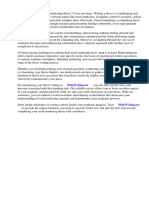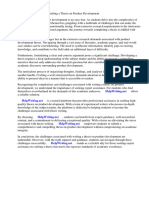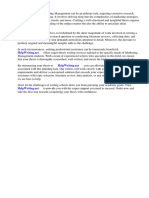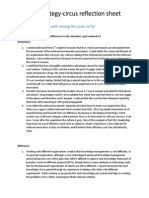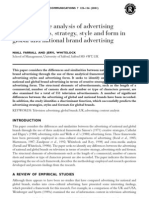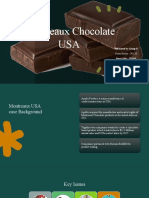0 ratings0% found this document useful (0 votes)
638 viewsStandardisation and Differentiation
Standardisation and Differentiation
Uploaded by
Allan Bqqweq
Copyright:
© All Rights Reserved
Available Formats
Download as PDF, TXT or read online from Scribd
Standardisation and Differentiation
Standardisation and Differentiation
Uploaded by
Allan B0 ratings0% found this document useful (0 votes)
638 views5 pagesqqweq
Copyright
© © All Rights Reserved
Available Formats
PDF, TXT or read online from Scribd
Share this document
Did you find this document useful?
Is this content inappropriate?
qqweq
Copyright:
© All Rights Reserved
Available Formats
Download as PDF, TXT or read online from Scribd
Download as pdf or txt
0 ratings0% found this document useful (0 votes)
638 views5 pagesStandardisation and Differentiation
Standardisation and Differentiation
Uploaded by
Allan Bqqweq
Copyright:
© All Rights Reserved
Available Formats
Download as PDF, TXT or read online from Scribd
Download as pdf or txt
You are on page 1of 5
At a glance
Powered by AI
The passage discusses P&G's strategy of standardizing some elements like production and distribution while differentiating elements like packaging, advertising and product features to appeal to local markets.
P&G uses a 'Transnational' global strategy, which allows them to consider geographical differences while maintaining economies of scale. This allows them to keep costs low while better meeting local customer needs.
P&G standardizes areas like production, distribution, R&D, the supply chain, and manufacturing processes to benefit from economies of scale.
Professional English Online Cambridge University Press 2012 ..PHOTOCOPIABLE..
Standardisation and differentiation
Marjorie Rosenberg
Aims
to be able to define these concepts
to express the pros and cons of
each of the concepts
to understand a text about a
multinational company
to learn the vocabulary used in
describing a companys strategy
to be able to discuss the strategy of
a multinational company
to consider the elements of
differentiation
to create a strategy of differentiation
for a product
to present your ideas to the class
Tasks
to agree on definitions
to fill in a chart with pros and
cons of each of the strategies
to read and understand a text
to match terms to their definitions
to talk about the strategy of a
multinational and offer your own
opinions about it
to discuss the elements of
differentiation and offer your own
ideas about the strategy
to work out a differentiation
strategy for a particular product
to present your ideas to the class
This activity can be used on its own or used together with Business Advantage
Advanced, Martin Lisboa and Michael Handford, Unit 2.
Level
Advanced (C1C2)
Timing
4045 minutes without the follow-up activity
This should include checking the answers, the discussions and the presentation of
ideas at the end.
Lead-in (10 minutes)
Students work in groups to define the two concepts. When they have finished, they
should share their ideas with the class and the definitions given below are compared
with those the class came up with. They then fill in two tables with the pros and cons
of the different strategies and these are discussed. Possible answers are given
below.
Standardisation: to give things of the same type the same basic features
Differentiation: to adapt products to different markets and target groups
Possible answers
Standardisation
Pros Cons
makes use of economies of scale
more control of quality and brand by
HO
easily recognisable
not suitable for every market
cannot compete with localised products
may indicate that company is out of
touch with specialised needs of market
Differentiation
Pros Cons
designed to appeal to particular group
more globally competitive
promotes cultural-awareness image of
company
more expensive to produce
may dilute brand name
may not be recognised as belonging to
company
Professional English Online Cambridge University Press 2012 ..PHOTOCOPIABLE..
Reading and vocabulary (10 minutes)
Students read the text and then work in pairs to match words from the texts with their
definitions.
Key
1 matrix structure 2 generate 3 distribution channels 4 transnational 5 supply
chain 6 economies of scale 7 foothold 8 evolve 9 emerging 10 cohesion
11 autonomy
Discussion (5 minutes)
Students work in groups to discuss several questions about the article.
Elements of standardisation and differentiation (5 minutes)
Students discuss elements of differentiation and try to give examples. They are
encouraged to add others to the list.
Working out a strategy (1015 minutes)
Students work in small groups to come up with a differentiated strategy for a
particular product in a foreign market. They should consider the elements above and
keep in mind the cost factor as well. When they finish, they present their ideas to the
class.
Follow-up
Students look on the internet for products sold world-wide and try to find differences
in features, packaging, advertising etc. from country to country. They can bring the
information to class to present to the others.
Sources
http://www.pg.com/en_US
http://wearedevelopment.net/2012/04/29/the-strategic-development-of-proctor-and-
gamble-into-a-global-giant
Professional English Online Cambridge University Press 2012 ..PHOTOCOPIABLE..
Standardisation and differentiation
Marjorie Rosenberg
Aims
to be able to define these concepts
to express the pros and cons of
each of the concepts
to understand a text about a
multinational company
to learn the vocabulary used in
describing a companys strategy
to be able to discuss the strategy of
a multinational company
to consider the elements of
differentiation
to create a strategy of differentiation
for a product
to present your ideas to the class
Tasks
to agree on definitions
to fill in a chart with pros and
cons of each of the strategies
to read and understand a text
to match terms to their definitions
to talk about the strategy of a
multinational and offer your own
opinions about it
to discuss the elements of
differentiation and offer your own
ideas about the strategy
to work out a differentiation
strategy for a particular product
to present your ideas to the class
Lead-in
Work in a small group and define these two words in reference to products produced
for both domestic and international markets.
Standardisation
Differentiation
Discuss the advantages and disadvantages of these two strategies. Fill in the tables
below and then present your ideas to the rest of the class.
Standardisation
Pros Cons
Differentiation
Pros Cons
Professional English Online Cambridge University Press 2012 ..PHOTOCOPIABLE..
Reading and vocabulary
Read the text and then work in pairs to find the underlined words in the text which
match definitions 111.
One global company which has evolved over the years is Procter and Gamble. The
Cincinnati, Ohio-based company has over 300 brands in 180 countries. As long ago
as the 1990s, P&G changed their strategy from a Global Product Structure to a
Transnational global strategy. This led them to consider the geographical
differences in the market places they were in and specialisation of particular brands
while maintaining economies of scale regarding areas such as production and
distribution. This strategy allowed them to keep costs low while giving them the
opportunity to better meet the needs of customers. In addition, this type of structure
has the advantage of making use of both centralised and decentralised functions
within the organisation. They can work efficiently and quickly to respond to
customers wishes on a local level while maintaining the brand image and quality the
company is known for. Key areas which require local customisation have been given
autonomy, but the R&D department stays centralised, meaning that the executives
running the company have control over it.
Today P&G is organised using a global matrix structure requiring control at various
levels and a great deal of cooperation and cohesion within the workforce. In order to
maintain the efficiency and brand recognition achieved by P&G it was necessary to
co-ordinate major parts of the business across nations. These included the
distribution channels, logistics, the supply chain, the manufacturing process and
finally putting an international IT system in place to oversee it all.
Today P&G is recognised world-wide as a global innovation leader with some of the
best-known household brands. Twenty-five of these brands each generate more than
$1 billion dollars in annual sales. Some 15,000 market research studies are carried
out annually around the globe and P&G prides themselves on interacting with more
than five million customers in nearly 100 countries. In order to stay on top of the
latest trends P&G works together with external companies who they seek out to help
them with innovation and new ideas to ensure their foothold in both established and
emerging markets.
Definitions
1. an arrangement within a company where employees are responsible to two or
more managers, often in different departments
2. to product or create something such as profits
3. methods that are used for selling a companys products or services, for example,
selling them through a distributor or a retailer
4. used to describe companies or business activities that exist or take place in more
than one country
5. the system of people and organizations that are involved in getting a product from
the place where it is made to customers
6. the reduction of production costs that is a result of making and selling goods in
large quantities, for example, the ability to buy large amounts of materials at
reduced prices
7. a strong first position in a market, industry, etc. from which further progress can
be made
8. to develop gradually, or to make someone or something change and develop
gradually
9. beginning to have economic power or success
10. the situation when the members of a group or company are united
11. the situation when a group of people can organise their own activities
Professional English Online Cambridge University Press 2012 ..PHOTOCOPIABLE..
Discussion
Do you think that P&G has a good strategy for both standardisation and
differentiation? Why or why not?
Which of their products do you know?
In which ways do you think they may change their products according to the
market?
Elements of standardisation and differentiation
Discuss these elements of differentiation. Try to find examples if you can. Can you
think of any others?
packaging
advertisements and advertising campaigns
USPs
colours
features
Working out a strategy
Work in small groups. Choose one of the products below and decide which of the
elements mentioned above should standardised to maintain the brand image and
which should differentiated depending on the market you are selling it in.
car shampoo fast-food restaurant
mobile phone computer software hotel chain
Put your ideas together and present them to the class. Discuss ideas the other
groups have and talk about the best strategy to make use of economies of scale
while meeting individual needs in markets.
Follow-up
Check the internet for products sold worldwide and try to find differences in features,
packaging, advertising etc. from country to country. Bring the information to present
to the rest of the class.
You might also like
- Segmentation Targeting and Positioning Strategy of AppleDocument14 pagesSegmentation Targeting and Positioning Strategy of AppleMaria Angelica MallariNo ratings yet
- Standardization Vs DifferentiationDocument5 pagesStandardization Vs Differentiationloganathprasanna100% (1)
- Vocab Power 7Document100 pagesVocab Power 7Alyssa Snow LonJon70% (23)
- TommylicasestudyDocument11 pagesTommylicasestudySrivatsan AravamudanNo ratings yet
- Ultimate Guide To Instagram GrowthDocument34 pagesUltimate Guide To Instagram GrowthAbarnaNo ratings yet
- Project On Volkswagen Entering in The Indian MarketDocument5 pagesProject On Volkswagen Entering in The Indian Marketशुभांगी सक्सेनाNo ratings yet
- Research Study On Youth Buying Behaviour Towards Smart Phones in DELHI NCRDocument36 pagesResearch Study On Youth Buying Behaviour Towards Smart Phones in DELHI NCRpulkit sachdevaNo ratings yet
- Business Advantage Advanced Unit2 Standardisation and DifferentiationDocument5 pagesBusiness Advantage Advanced Unit2 Standardisation and DifferentiationIgnacio Lombardi0% (1)
- MGMT2013 Unit5Document15 pagesMGMT2013 Unit5bgdby2fv9kNo ratings yet
- Business Advantage Upper Intermediate Unit10 BrandingDocument5 pagesBusiness Advantage Upper Intermediate Unit10 BrandingytürkarslanNo ratings yet
- GSBA504Document6 pagesGSBA504Hunganistan JózsefNo ratings yet
- Business Advantage Advanced Unit1 Market Entry StrategiesDocument5 pagesBusiness Advantage Advanced Unit1 Market Entry StrategiesIgnacio Lombardi100% (1)
- Thesis Topics For Product DevelopmentDocument6 pagesThesis Topics For Product DevelopmentWillYouWriteMyPaperForMeCanada100% (2)
- IBT-MODULE 9..2b.mktgDocument12 pagesIBT-MODULE 9..2b.mktgRamil VillacarlosNo ratings yet
- Global Standardization in International MarketingDocument13 pagesGlobal Standardization in International MarketingZuna ShahidNo ratings yet
- PositioningDocument17 pagesPositioningBiya ButtNo ratings yet
- 411 Product Management-1Document110 pages411 Product Management-1Awadhesh YadavNo ratings yet
- Project Description: Marketing in An International Context Group AssignmentDocument4 pagesProject Description: Marketing in An International Context Group AssignmentAhmed HusseinNo ratings yet
- Green Marketing Thesis ProposalDocument8 pagesGreen Marketing Thesis Proposaltonyarobertsknoxville100% (1)
- Product Diversification Literature ReviewDocument8 pagesProduct Diversification Literature Reviewafdtynfke100% (1)
- Assignment Group Global MarketingDocument3 pagesAssignment Group Global Marketingandre suryantoNo ratings yet
- Strategic Management of Declining Industries - A Literature ReviewDocument7 pagesStrategic Management of Declining Industries - A Literature Reviewc5r9j6zjNo ratings yet
- 626a9f4c1890fc00104b79ce-1651154965-MODULE 3Document6 pages626a9f4c1890fc00104b79ce-1651154965-MODULE 3Marcelo Santos IINo ratings yet
- Master Thesis Brand ManagementDocument6 pagesMaster Thesis Brand Managementfjgtq12d100% (2)
- Business Strategy Marketing-Case Study Assignment HelpDocument8 pagesBusiness Strategy Marketing-Case Study Assignment HelpExpertsmindEduNo ratings yet
- International Marketing 2013 PDFDocument27 pagesInternational Marketing 2013 PDFNaxiloNo ratings yet
- 3484-3119 Kotler Mm13e Im 12Document17 pages3484-3119 Kotler Mm13e Im 12arsenal87No ratings yet
- Brand ManagementDocument12 pagesBrand ManagementRajat VijNo ratings yet
- Retail Marketing ThesisDocument6 pagesRetail Marketing ThesisBuyCustomPaperCanada100% (2)
- BUS 5112 - Marketing Management-Portfolio Activity Unit 3Document6 pagesBUS 5112 - Marketing Management-Portfolio Activity Unit 3YoYoNo ratings yet
- IB - RevisionDocument23 pagesIB - Revision22003406No ratings yet
- International Marketing Course Outline PDFDocument15 pagesInternational Marketing Course Outline PDFAhmed Mansour ShahenNo ratings yet
- DocxDocument14 pagesDocxAimee Ayson De AsisNo ratings yet
- Instant download Framework for Marketing Management Global 6th Edition Kotler Solutions Manual pdf all chapterDocument46 pagesInstant download Framework for Marketing Management Global 6th Edition Kotler Solutions Manual pdf all chapterktpyahan100% (3)
- Keller Sbm3 Im 03Document6 pagesKeller Sbm3 Im 03Ali razaNo ratings yet
- Thesis Paper On Product DevelopmentDocument4 pagesThesis Paper On Product DevelopmentBuyCheapPapersMiramar100% (2)
- Designing Organizations For The International EnvironmentDocument38 pagesDesigning Organizations For The International EnvironmentBayan MohammedNo ratings yet
- Framework For Marketing Management Global 6th Edition Kotler Solutions Manual 2024 Scribd Download Full ChaptersDocument46 pagesFramework For Marketing Management Global 6th Edition Kotler Solutions Manual 2024 Scribd Download Full Chapterskawkebjuljen100% (2)
- Find Marketing Dissertation TopicDocument8 pagesFind Marketing Dissertation TopicBuyCollegePaperSouthBend100% (1)
- INB303 Final notesDocument6 pagesINB303 Final notesSaiful IslamNo ratings yet
- Marketing ProjectDocument6 pagesMarketing ProjectAhishakiye Cléo ClovisNo ratings yet
- Mkt744 Assessment Global Marketing and Sales Development International Marketing Evaluation & Strategy (100% Coursework)Document2 pagesMkt744 Assessment Global Marketing and Sales Development International Marketing Evaluation & Strategy (100% Coursework)Zubair Afzal KhanNo ratings yet
- Strategies For Building A Better Brand ImageDocument15 pagesStrategies For Building A Better Brand Imageemail2src100% (1)
- Example Marketing Dissertation TitlesDocument8 pagesExample Marketing Dissertation TitlesWhatIsTheBestPaperWritingServiceCanada100% (1)
- Corporate StrategyDocument113 pagesCorporate Strategymattia.aprile28No ratings yet
- Product Strategies: Xitij NanavatyDocument37 pagesProduct Strategies: Xitij NanavatyXitij NanavatyNo ratings yet
- Entrepreneurship: Quarter 1 - Module 5 7 P's of Marketing and BrandingDocument25 pagesEntrepreneurship: Quarter 1 - Module 5 7 P's of Marketing and BrandingSenjuPH100% (2)
- Thesis Marketing ManagementDocument8 pagesThesis Marketing ManagementBuyPapersOnlineUK100% (2)
- Tutorial Program - 2011 MPIDocument3 pagesTutorial Program - 2011 MPIPareena Naggea-SharmaNo ratings yet
- Sales and Marketing Dissertation TopicsDocument5 pagesSales and Marketing Dissertation TopicsWriteMyPaperForMeCheapUK100% (1)
- Marketing Masters Dissertation PDFDocument8 pagesMarketing Masters Dissertation PDFScientificPaperWritingServicesUK100% (1)
- Brand ArchitectureDocument8 pagesBrand ArchitectureNabeelah Moses100% (1)
- Tapping Into Global MarketsDocument19 pagesTapping Into Global MarketsMathew JcNo ratings yet
- Culture Worksheet 1Document4 pagesCulture Worksheet 1fromSpaceNo ratings yet
- Strategy Reflection Sheet by Vikas, IIM LucknowDocument5 pagesStrategy Reflection Sheet by Vikas, IIM LucknowVikas HajelaNo ratings yet
- 11 Entrepreneurship - Module 2Document8 pages11 Entrepreneurship - Module 2Sir AkhieNo ratings yet
- Market Strategy MBADocument8 pagesMarket Strategy MBAjlmesaleschampionsNo ratings yet
- B2B MarketingDocument9 pagesB2B MarketingSandarbh GoswamiNo ratings yet
- Keller SBM4 IM 01Document12 pagesKeller SBM4 IM 01ahmad_sokarNo ratings yet
- Chapter 2Document74 pagesChapter 2kadambari yadavNo ratings yet
- Discussion QuestionsDocument5 pagesDiscussion Questionsbokikg87No ratings yet
- Kotler12 ImDocument20 pagesKotler12 ImRahul JagwaniNo ratings yet
- Conceptual Analysis of Brand Architecture-A Study in Global PerspectiveDocument10 pagesConceptual Analysis of Brand Architecture-A Study in Global PerspectiveVenkateshwar Rao. RokandlaNo ratings yet
- International Strategy: Giorgio Zanarone HEC Lausanne University of LausanneDocument21 pagesInternational Strategy: Giorgio Zanarone HEC Lausanne University of LausannegregNo ratings yet
- Dealing with Darwin (Review and Analysis of Moore's Book)From EverandDealing with Darwin (Review and Analysis of Moore's Book)No ratings yet
- Online Dating G21321uideDocument102 pagesOnline Dating G21321uideAllan B0% (1)
- Ancient Egyptian Myths: The Betrayal of Set The Betrayal of SetDocument6 pagesAncient Egyptian Myths: The Betrayal of Set The Betrayal of SetAllan BNo ratings yet
- Business Law ExamDocument2 pagesBusiness Law ExamAllan BNo ratings yet
- ESL TOEFL Interwefewmediate VocabularyDocument28 pagesESL TOEFL Interwefewmediate VocabularyAllan BNo ratings yet
- Job Satisfaction and Google Lesson PlanDocument3 pagesJob Satisfaction and Google Lesson PlanAllan BNo ratings yet
- Adjective ClausesDocument28 pagesAdjective ClausesAllan B100% (1)
- The Adjective Clause Worksheet: © This Worksheet Is FromDocument2 pagesThe Adjective Clause Worksheet: © This Worksheet Is FromAllan BNo ratings yet
- Business English Placement TestDocument8 pagesBusiness English Placement TestAllan BNo ratings yet
- Daily Business Vocab TestDocument2 pagesDaily Business Vocab TestAllan BNo ratings yet
- Digital Fashion & LifestyleDocument20 pagesDigital Fashion & LifestyleObinnaNo ratings yet
- The Case of The Zara Group in European Business and Brand BuildingDocument24 pagesThe Case of The Zara Group in European Business and Brand BuildingPablo OzoresNo ratings yet
- Communicating Value - PatamilkaDocument12 pagesCommunicating Value - PatamilkaNeha ArumallaNo ratings yet
- STP of DominosDocument8 pagesSTP of DominosAbhijit PandaNo ratings yet
- 01f90module 3 AmizoneDocument36 pages01f90module 3 AmizoneMayankTayalNo ratings yet
- BUSI4153-Group 5 - Case Analysis-PepsiCoDocument9 pagesBUSI4153-Group 5 - Case Analysis-PepsiCoJeffrey O'LearyNo ratings yet
- A Project Report On "A Study of Consumer Behaviour" AT: Savitribai Phule Pune UniversityDocument81 pagesA Project Report On "A Study of Consumer Behaviour" AT: Savitribai Phule Pune UniversityRonak PatelNo ratings yet
- Unit 2: International Markets (Homework)Document8 pagesUnit 2: International Markets (Homework)Hoài My Lê ThịNo ratings yet
- Demo Project SamsungDocument76 pagesDemo Project SamsungMayaNo ratings yet
- Session 7 - Global Product Policy DecisionsDocument64 pagesSession 7 - Global Product Policy DecisionsThông Nguyễn MinhNo ratings yet
- DaMilano HidesignDocument10 pagesDaMilano HidesignNatasha SinhaNo ratings yet
- P&G CEO AG Lafley 2007 SpeechDocument18 pagesP&G CEO AG Lafley 2007 SpeechMerries100% (5)
- Bajaj Auto - Strategic AnalysisDocument41 pagesBajaj Auto - Strategic AnalysismohanjaiNo ratings yet
- Cover Letter Espanol EjemploDocument4 pagesCover Letter Espanol Ejemplof5d5wm52100% (3)
- Brand ManagementDocument181 pagesBrand ManagementSáas JainNo ratings yet
- Full Term WorksheetDocument157 pagesFull Term Worksheethalle cNo ratings yet
- A Comparative Analysis of Advertising CharacteristicsDocument12 pagesA Comparative Analysis of Advertising CharacteristicsaliziiNo ratings yet
- Group 8 - Montreaux ChocolateDocument10 pagesGroup 8 - Montreaux ChocolateNikhil PathakNo ratings yet
- SWOT Analysis: A) StrengthsDocument2 pagesSWOT Analysis: A) StrengthsSonam Tshering Thingh100% (1)
- Case Study of StarbucksDocument3 pagesCase Study of StarbucksAnonymous MZRzaxFgVLNo ratings yet
- Marketing An Introduction, Bab 15Document39 pagesMarketing An Introduction, Bab 15Rien AnggreaniNo ratings yet
- DoubleTree by Hilton Hanoi WestDocument113 pagesDoubleTree by Hilton Hanoi Westnb.forwork112790No ratings yet
- Marketting & Sales Management: Page 1 of 6Document6 pagesMarketting & Sales Management: Page 1 of 6romanNo ratings yet
- Self-Learning Materials in Arts: Line Is A Point or A Dot Drawn Continuously, It Can Be Either Straight or CurveDocument12 pagesSelf-Learning Materials in Arts: Line Is A Point or A Dot Drawn Continuously, It Can Be Either Straight or CurveElc Elc ElcNo ratings yet
- MFilterIt - App Traffic ValidationDocument9 pagesMFilterIt - App Traffic ValidationhansNo ratings yet




























